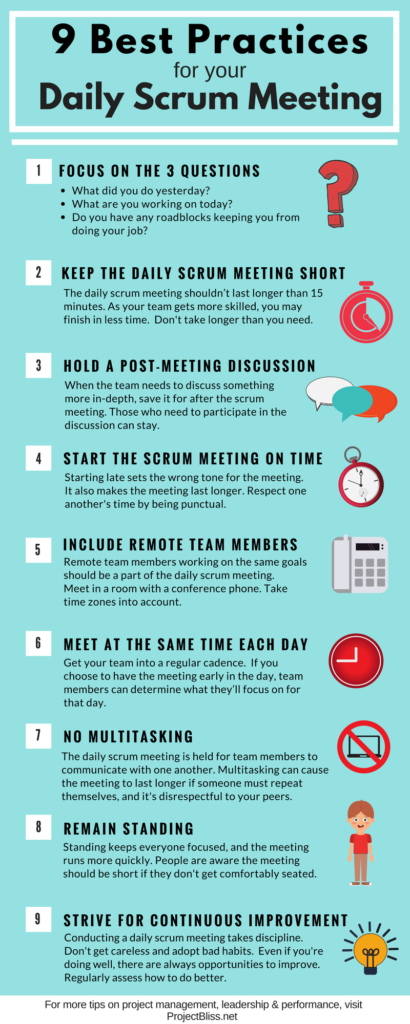When my team first started holding a daily scrum meeting, it honestly felt awkward. I was accustomed to meetings with in-depth communication. So at first, the act of the team standing around giving brief answers felt stilted and strange to us – or maybe it was just me.
We stumbled through our first few. But as we continued, we got more comfortable with the routine.
We got so comfortable, as a matter of fact, that we began to slack a bit. We didn’t run the meetings as well as we could have. At times we came in late, looked at our smartphones, rambled.
But because we’re a self-organizing, high-performing team, we recognized our faults. We agreed to do better. And we did.
And now our meetings run beautifully.
From the lessons I’ve learned through experience, I’ve compiled nine best practices that have helped our daily scrum meetings stay focused and efficient.
I proposed the Daily Scrum Meeting, along with two other activities, as an Agile practice you can adopt if you want to gain some of the benefits of Agile – even if your team hasn’t adopted full Agile.
The Purpose of the Daily Scrum Meeting
Let’s quickly level-set on the intent of the daily scrum. In “The Scrum Guide” Ken Schwaber and Jeff Sutherland point out that the daily scrum is a mini planning event. I see a bit of status there too, but knowing current status helps plan next steps.
The communication in the daily scrum meeting helps the team understand how they’ll work together to accomplish the goals. The input tells teammates how they’re doing in working toward the team goals, and the output helps shape actions going forward.
The meeting is intended to be a short, focused meeting to communicate across the team quickly. It’s not meant for team members to talk only to the scrum master. The team members are communicating with each other. This helps them all know what’s complete, what’s needed, and what may be preventing them from moving forward. The scrum master is a servant-leader who removes roadblocks and helps the team succeed.
9 Best Practices for Your Daily Scrum Meeting
1. Focus on the 3 Questions
In “3 Easy Agile Practices Your Team Can Start Today” I list the three questions each team member will answer during the daily scrum meeting.
- What did you do yesterday?
- What are you working on today?
- Do you have any roadblocks keeping you from doing your job?
By focusing on these three questions, your team provides useful information to one another. These questions are beneficial for multiple reasons.
What did you do yesterday? When answering this question, team members report on progress. It also highlights whether team members are working on items that not related to team goals. And it gives team members a sense of accomplishment to say that they’ve completed a task, story, or piece of work.
What are you working on today? Stating what you’ll be working on today helps you get focused. It forces to you evaluate whether your work moves your goals forward. It lets others know if they need to be ready for work to come their way. For example, Todd shares that he plans to finish making changes to the approval process flow today. Sandy then knows that she can test it tomorrow.
Do you have any roadblocks keeping you from doing your job? The final question gives visibility to what is standing in the way of progress. The scrum master then knows that there are roadblocks she needs to help with. Or a team member may have a roadblock that anther team member can quickly assist in resolving.
2. Keep the Daily Scrum Meeting Short
The daily scrum meeting shouldn’t last longer than 15 minutes. When a team first starts the daily scrum meeting practice, it’s not uncommon for them to use all this time. However, as your team gets more skilled, the daily scrum meetings will be completed more quickly. You might even finish in 10 minutes or less.
3. Hold a Post-Meeting Discussion
Recognize when the team is getting into details that go beyond the three questions. When my team first started the daily scrum meeting, our biggest struggle was knowing how in-depth to answer the three questions. If a team member starts to get into too many technical details, you need a separate conversation. This is necessary for multiple reasons:
- A topic needs a more in-depth conversation.
- Not everyone needs to be a part of the proposed discussion. When you hold the deeper conversation afterward, those not involved or interested can leave.
When my team recognizes that we’re getting too detailed or we need a more in-depth discussion, any one of us is free to say the words “post-meeting.” By doing so, we recognize we need to table it, move on, and come back to this topic after our daily scrum meeting. We have a whiteboard available, and if there are items to be discussed afterward, we add it to the list. Then once we’ve finished our daily scrum meeting, we state that anyone who wants to leave can do so. Then those remaining go into more detailed conversations regarding the needed items.
4. Start the Scrum Meeting on Time
As stated above, the daily stand up should be a short, focused meeting. If the session is only 15 minutes long, and you start 5 minutes late, then you’ve added 33% more time to the meeting. And if the meeting is only 10 minutes long, and you start 5 minutes late, you’ve added 50% more time! Starting late sets the wrong tone for the meeting. You want to show that you respect the team’s time, and they also should respect one another’s time by being punctual. Agile takes discipline. Pay attention to the small things. These can make a big difference in the message you send about how you expect to perform.
5. Include Remote Team Members in the Daily Scrum Meeting
Having team members who work offsite is common. If you have remote team members working on the same goals, they should be a part of the daily scrum meeting. You can easily accomplish this by meeting in a room with a conference phone. Take time zones into account and find a time that works for everyone as best as possible.
6. Have the Scrum Meeting at the Same Time Each Day
By meeting at the same time, your team gets into a regular cadence. It becomes standard practice for your team. If you choose to have the meeting early in the day, team members can determine what they’ll focus on for the day.
7. No Multitasking
Seriously. For some reason, this is a hard one. The daily scrum meeting is a communication vehicle for all team members. The intent isn’t for each team member to communicate with the scrum master, but rather with each other. Therefore, everyone needs to pay attention. I’ve seen team members bring laptops in and work during the daily scrum meeting. Do not do it. If I’m reading a text from Jill in marketing, and Sarah shares that she’s having an issue, I may miss a critical piece of information. Plus, it’s disrespectful. Sarah – and everyone else – can see me reading my text. Again – pay attention to these little things.
8. Remain Standing
When the team remains standing it reminds them that this is not a regular status meeting. It keeps everyone focused, and the meeting runs more quickly. People are more aware that the meeting should be short if they don’t get comfortably seated. I’ve known teams to hold meetings in areas where there were no chairs to remove the temptation to sit. If you are in an area with chairs, set an agreement among all participants that you’ll stand.
9. Strive for Continuous Improvement
Conducting a daily scrum meeting takes discipline. Team members can get careless and start to run the meetings less efficiently. And even if you’re doing well, there are always opportunities to improve. Get buy-in and agreement from the group that you’ll regularly assess how to improve. Identify the cadence or milestones that trigger a group self-assessment. If you’re running two-week sprints, conduct a retrospective at the end of each sprint.
Conclusion
These 9 best practices will set your scrum meetings up for success. Get all team members to agree to run your meetings using these behaviors. Then go forward supporting one another to stick to them.
This may seem like a lot to keep in mind. Print the Infographic provided below and bring it with you to your daily scrum meetings. Having this with you as a reference will help you all be more disciplined.
And once other teams find out how well yours are run, share your secrets with them, too!




No Responses